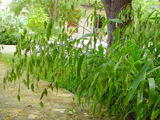Native Plants

Q. Who is Mr. Smarty Plants?
A: There are those who suspect Wildflower Center volunteers are the culpable and capable culprits. Yet, others think staff members play some, albeit small, role. You can torture us with your plant questions, but we will never reveal the Green Guru's secret identity.
Did you know you can access the Native Plant Information Network with your web-enabled smartphone?
Ask Mr. Smarty Plants is a free service provided by the staff and volunteers at the Lady Bird Johnson Wildflower Center.

rate this answer
Wednesday - July 22, 2009
From: Mooresville, NC
Region: Southeast
Topic: Water Gardens, Compost and Mulch, Grasses or Grass-like
Title: Native water plants for bio-retention pond in North Carolina
Answered by: Barbara Medford
QUESTION:
I am looking for North Carolina native plants that can take part shade and very wet conditions (bioretention pond environment). Any suggestions?ANSWER:
Although we are going to give you a list of native plants for North Carolina from our own Native Plant Database, we thought you might also like to look at Recommended Native Plant Species for Stream Restoration in North Carolina by Karen Hall, NC Stream Restoration Institute, North Carolina State University.
An excerpt from a previous Mr. Smarty Plants response to a similar question; this time it was referred to as a "bioswale." You didn't say what your soil is, but there is a very good website included in this excerpt on bioswale construction, which may or may not be apropos to your situation.
Common swales are typically vegetated with turf grass and are a conveyance tool, basically a grassy stormwater sewer that conveys water as quickly as possible from Point A to Point B. A bioswale differs in that the turf grass is replaced with native prairie vegetation. This will significantly reduce the flow velocity (slow down of the runoff) in the swale’s drainage course. The residence time of the runoff is thus increased, which gives it the time to be stored, filtered, and infiltrated. These processes remove pollutants and suspended solids from runoff.
In terms of soil, we found this information on bioswale construction, from the USDA, which shows compost tilled into the native soil (clay, in this instance) to facilitate the drainage. The plants we have selected are all perennial, tolerate shade, and will grow in moist, clay soils. These are plants with fibrous roots that will hold in the soil when water is rushing by, help to slow it down, and permit the pollutants in the water to be filtered out.
Since many of our suggestions are basically for prairie grasses, you might be interested in reading our How-To Article Recreating a Prairie, which has instructions for time of year to be planting, preparing the soil, planting and caring for the grasses. We will also recommend some other plants that can stand wet feet and shady conditions. Follow the web link to the page for the individual plant, and decide which plants will best suit your purposes. When you are ready to begin, go to our Native Plant Suppliers section, put your town and state in the Enter Search Location box, and you will get a list of native plant nurseries, seed companies and landscape consultants in your general area who can help you select the right plants for your purpose.
Plants for shady and wet conditions
Andropogon gerardii (big bluestem)
Arundinaria gigantea (giant cane) - pictures
Calamagrostis canadensis (bluejoint)
Chasmanthium latifolium (Inland sea oats)
Cladium mariscus ssp. jamaicense (Jamaica swamp sawgrass)
Leersia oryzoides (rice cutgrass)
Typha latifolia (broadleaf cattail)
Asclepias incarnata (swamp milkweed)
Bacopa monnieri (herb of grace)
Equisetum arvense (field horsetail)
Equisetum hyemale var. affine (scouringrush horsetail)
Equisetum hyemale (scouringrush horsetail)
Helianthus angustifolius (swamp sunflower)
Iris prismatica (slender blue iris)
Justicia americana (American water-willow)
Phyla nodiflora (turkey tangle fogfruit)
More Grasses or Grass-like Questions
Native grasses for horse grazing in Wichita Falls, TX
September 08, 2009 - What are the best horse grazing grasses to plant in the Wichita Falls, Texas area?
view the full question and answer
Trimming of cordgrass plants
November 20, 2007 - We have planted more than 150 cordgrass plants (spartina bakeri) along the edges of the small pond at our condominium complex to try to prevent any further soil erosion between the buildings and the p...
view the full question and answer
Removing Center Stem From Desert Spoon (Sotol) in Phoenix
March 11, 2016 - I have a desert spoon. I hate the center stem. Can I remove the center stem without hurting the rest of the plant? And what is the best way to remove it? I looked for this answer in your questions bu...
view the full question and answer
Thicken clumps of Panicum virgatum in Stafford VA
July 22, 2009 - I am growing Panicum Virgatum varieties that will be transplanted in September to form a Native American maze project. I have given the quart size starts a root fertilizer when I planted them to try ...
view the full question and answer
Sources for native plants from Austin TX
December 19, 2012 - Hello. I am currently planning a Texas native plant garden. Unfortunately, I cannot seem to find the seeds/bulbs/roots/plants for some of the natives at local nurseries: Indian Ricegrass (Achnatherum ...
view the full question and answer
| Support the Wildflower Center by Donating Online or Becoming a Member today. |

